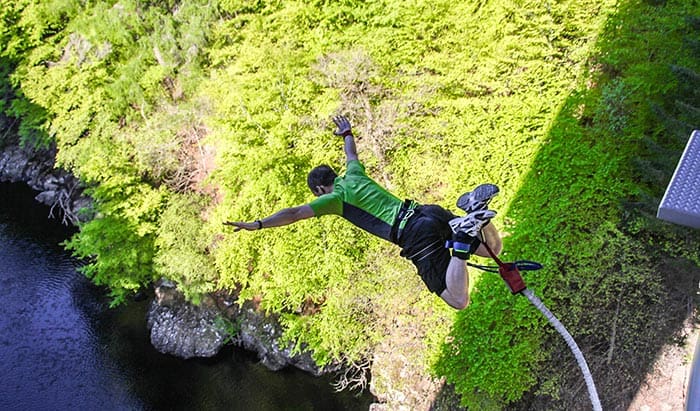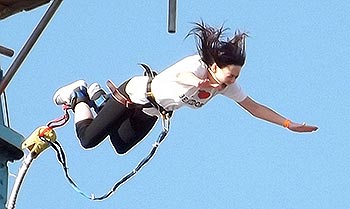Any adrenaline-seeker wants to try bungee jumping, just one of several thrilling extreme sports. Bungee jumping may be for you if you appreciate taking significant risks. However, you have to wonder: just how dangerous is bungee jumping?
Contents
What is Bungee Jumping?
When bungee jumping, the ankles are secured to a thick, elastic cord, allowing the jumper to land on their feet first. Bungee jumpers often launch themselves from tall structures like skyscrapers, bridges, or cranes. However, it has also been accomplished by moving objects.
As the jumper falls freely from a height, the cord extends, and as the line bounces back, the momentum lifts the jumper upwards. The elastic cord keeps moving up and down in a trampoline-like pattern until it runs out of juice.
The majority of bungee operations around the world are managed by skilled and knowledgeable professionals who use the best and most reliable equipment. They also abide by strict safety regulations. Although falling from such heights can seem alarming, bungee jumping is a risk-free hobby with a stellar safety record.
Bungee Jumping Equipment
Bungee jumping involves an elastic rope called a braided shock cable attached to the jumper’s ankle. The majority of bungee cables are made of natural rubber, which is used because of its inherent elasticity. For bungee jumping, a body and leg harnesses are connected to the line (back-up for the ankle attachment, for safety purposes).
The Risks of Bungee Jumping
You might still not be convinced that bungee jumping is safe. Here are the risks you should be aware of when considering how dangerous is bungee jumping.
Eye Injuries
Bungee jumping frequently leads to eye injuries because of the sharply increased pressure in the eyes. The sudden upward jerk of the elastic chord causes fluid to rush to your brain, increasing the blood pressure inside the blood vessels in your eyes.
This pressure increase can destroy your retina, the layer of cells at the back of your eye that directly communicates with your brain, as well as your conjunctiva, the thin mucous membrane covering your eyes. Usually, injuries to these areas of your eyes cause a temporary loss of vision. Spots, eye infections, and hemorrhages are all possible.
Spine Injuries
Your spine’s vertebrae and the delicate spinal cord they are supposed to protect could be harmed by the intense pressures your body encounters when the bungee cord pulls it back up. The most frequent injuries are compression fractures, broken bones in the spine, herniated discs, and spaces between the vertebrae.
Although these wounds are treatable, they can become too severe and irreparable. If the spinal cord within the vertebrae is damaged, quadriplegia, or the inability to move your arms and legs, may result.
Neck Injuries
Your neck is at risk when you bungee jump, and injuries can range from minor to severe. The final part of the jump can cause enough force to press against your neck muscles, cause pain, and briefly limit your range of motion by applying pressure to the delicate area of your body that connects your brain and spinal cord.
Additionally, a jumper’s neck has on occasion mistakenly become wrapped up in the bungee cord. When this happens, it can choke the jumper and restrict the blood flow to their brain, making breathing difficult or impossible. In these circumstances, the jumper must be saved as soon as possible to prevent death.
Death
Unfortunately, deaths from bungee jumping can occur infrequently. If a jumper’s neck gets twisted in the cord for even a short period, his injury will be deadly. He is unable to get enough oxygen to his brain. Another frequent reason for fatal bungee jumping injuries is a too-long cable.
Because they neglected to consider the cord’s elasticity, individuals tumble and hit their skulls on the ground, dying from the impact. Even seasoned bungee jumpers can make these mistakes and endanger their lives. The day prior to the Super Bowl in 1997, a professional bungee jumper practicing for the halftime show at the Superdome banged her head on the cement floor during a jump and died due to head trauma.
Health Risks
Given that bungee jumping is a relatively new sport, it is difficult to establish whether there are any long-term health risks. According to doctors who have studied bungee jumpers, the hazards are minimal in the short term.
The most common complaint among jumpers in the moments after their jump is dizziness. This annoyance usually goes away before the day is over. A tiny percentage of participants said they experienced back or ankle musculoskeletal pain a few days after their jump. However, this pain usually went away soon.
How to Make Bungee Jumping Safe?
For a leap to be deemed safe, the bungee cord needs to be tied off in a secure location that won’t be affected by the additional weight. Steel railings or safety fences frequently provide great anchor points. Professionals will also ensure that the bungee rope is tied with weight-bearing knots to hold even while the jumpers are being pushed downward by gravity.
Some companies may place airbags, webbing, or slings directly below the jump space to guarantee jumpers’ safety. Locations with webbing and airbags might make the first jump for beginners safer.
Optimal Weather
Since the equipment might not operate properly in the rain, snow, or other unideal weather conditions, certain businesses may need to postpone jumps. Additionally, locations with low vision and unstable wind conditions are more likely to result in injuries.
A jump aspect that increases risk should be avoided. Work with experts and take all the safety measures you can.
Ideal Clothing
Although there isn’t a set dress code for this sport, some attire helps maintain safety. Avoid wearing too loose clothing since it can restrict the bungee cord. Remove any jewelry or anything that could be dangerous if they fell off or came loose before jumping. Among them are spectacles, contact lenses, and jewelry.
Training
Whether you are a novice, a lightly experienced, or a professional bungee jumper, there are three-part programs that teach skills like the inspection, testing, and maintenance of bungee equipment and how to use them. An apprenticeship period, bungee training, and rescue training make up the teachings.
Minimum Requirements
The minimal requirements for each bungee operation would vary based on the height and complexity of the jump. The minimum age is usually 12 to 14 years old, and the maximum weight is typically 110 kg, provided that you are in decent physical and mental shape. 35 kg is the required minimum weight.
Medical Conditions
Women who are pregnant, those with high blood pressure, an irregular heartbeat, illnesses of the legs, back, respiratory system, or circulatory system, as well as those who have just had surgery, are advised against bungee jumping and should instead consult their doctors beforehand.
Last Word
How dangerous is bungee jumping? Bungee jumping comes with risks, but so do all extreme sports. But as long as you prioritize safety and minimize risks, the activity can be safe and fun for you.


